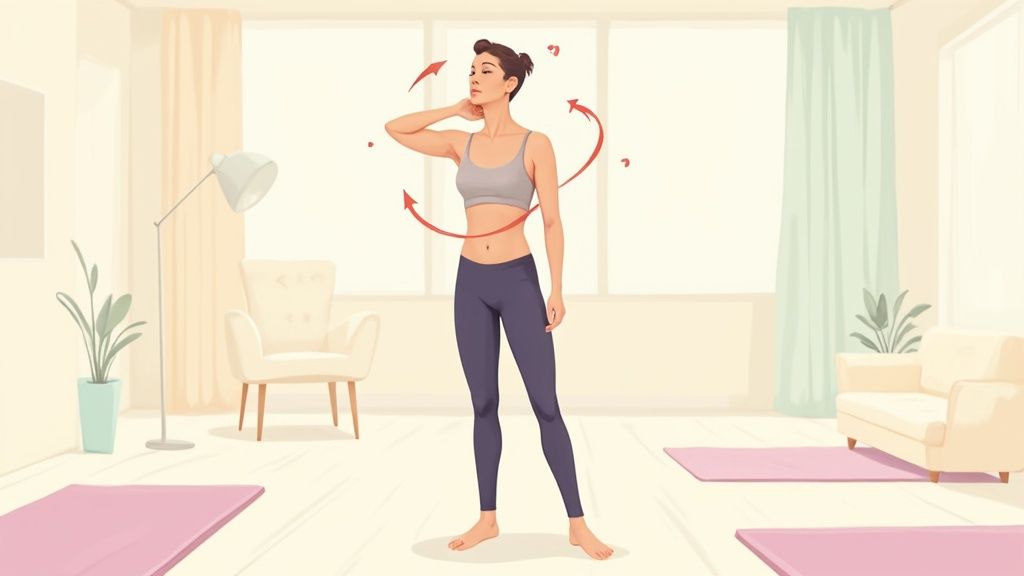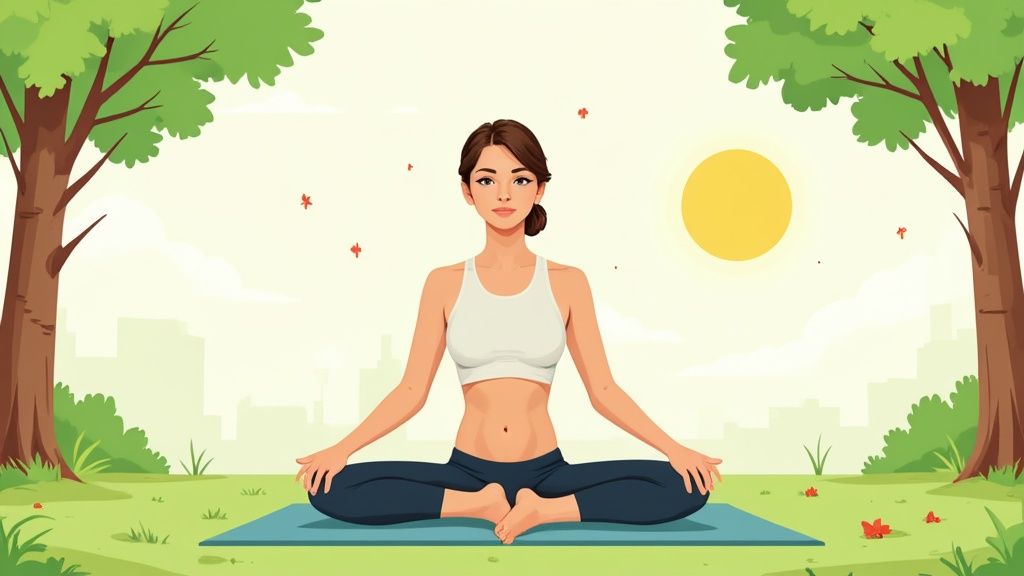8 Proven Neck Pain Relief Exercises That Actually Work
Understanding Your Neck Pain Journey

That stubborn ache in your neck and shoulders can make even simple daily tasks challenging. You're not alone - research shows that around 75% of people deal with neck pain at some point. The discomfort affects everything from work focus to sleep quality. Getting to know your specific neck pain patterns and triggers is essential for finding exercises that will actually help relieve your pain.
Identifying the Root of the Problem
Some people experience brief episodes of neck pain that quickly resolve on their own. For others, it becomes an ongoing issue that persists over time. There are many possible causes - maybe you spend hours hunched over your computer, make repetitive movements, carry stress in your shoulders, or have an underlying condition like arthritis. For example, poor desk posture often leads to tight, stiff neck muscles. Understanding what's causing your particular neck pain helps determine the most helpful treatment approach.
When Exercises Can Help (and When to Seek Professional Advice)
Simple neck exercises work well for many people, especially when muscle tension, posture problems, or minor strains are to blame. The exercises strengthen and stretch key neck muscles while improving flexibility and range of motion. Just like a rusty door hinge moves better with regular use, neck exercises help your joints function more smoothly through movement. However, if you have severe pain, numbness/tingling in your arms or hands, or a recent injury, talk to your doctor first. They can properly diagnose the issue and guide you on the best treatment plan, which may combine medical care with targeted exercises.
The Power of Targeted Movement
The key to effective neck pain relief exercises is their focused, purposeful nature. Rather than random stretches, these movements target specific muscle groups and imbalances contributing to your discomfort. Think of it like watering a garden - you'll get better results directing water right to each plant's roots versus spraying randomly. Properly chosen neck exercises can significantly decrease pain, expand your range of motion, and improve how your neck functions overall. By learning what drives your neck pain and selecting appropriate exercises, you can take active steps toward feeling better.
Quick-Relief Stretches That Actually Work

Now that we understand what causes neck pain, let's explore some simple stretches that can provide immediate relief. Physical therapists often recommend these specific exercises because they target the key muscles involved in neck discomfort. When done regularly, these stretches can help improve your flexibility and range of motion over time.
Gentle Neck Rotations
One of the most basic yet helpful ways to ease neck stiffness is through gentle rotations. This movement helps loosen up the joints in your neck, similar to oiling a stiff door hinge. Start by sitting with good posture and slowly turn your head to one side, as if trying to look over your shoulder. Hold briefly, then return to center. Do this 5-10 times on each side. If you feel any sharp pain, reduce how far you turn or stop completely. This careful approach helps prevent strain while working within your comfort zone.
Levator Scapulae Stretch
The levator scapulae muscle runs from your neck to your shoulder blade and often causes pain when you have poor posture. To stretch this muscle effectively, start by sitting or standing straight. Tilt your head toward one shoulder, bringing your ear closer to your chest. Then slightly turn your head to look down toward your armpit. You should feel a gentle pull along your neck's back and side. Hold for 20-30 seconds before switching sides. For a deeper stretch, you can gently pull the back of your head with your hand on the same side.
Chin Tucks and Head Lifts
These exercises work by strengthening the deep muscles in your neck that control posture. When these muscles are weak, your head tends to drift forward, which often leads to pain. For chin tucks, draw your chin back while keeping your eyes level, creating a slight double chin. Hold briefly, then release. For head lifts, lie down with bent knees and feet flat. Lift your head slightly while maintaining the chin tuck position. Hold for a few seconds, then lower slowly. Try for 10-15 repetitions of each exercise, taking breaks when needed. The combination of these movements helps maintain proper neck alignment.
Doorway Stretch for the Chest
When chest muscles get tight, they pull your shoulders forward and contribute to neck pain. A simple doorway stretch can help fix this. Stand in a doorway and place your forearms on the frame with elbows at 90 degrees. Step forward until you feel a stretch across your chest and shoulders. Hold for 20-30 seconds. You can adjust the height of your arms to target different parts of your chest - higher placement stretches the upper chest, while lower placement focuses on the lower chest. Making this stretch part of your routine helps improve upper body mobility and reduces neck strain.
Building Your Neck's Natural Armor

While stretching helps with neck pain, building strength is essential for long-term relief. Let's explore specific exercises that strengthen the key muscles supporting your neck's stability and movement.
Understanding Deep Cervical Flexor Exercises
The deep cervical flexors are a group of muscles that work like your neck's core - they control small movements and maintain proper head position. Just as strong abs support your back, these muscles keep your head balanced and aligned. Research shows focused training can more than double neck strength in many cases, highlighting how effective these often-overlooked exercises can be for neck pain relief.
Progressing Safely and Effectively
The key to strengthening your neck is starting slow and building gradually. Begin with gentle holds that contract the muscles without movement, like simple chin tucks held for a few seconds. As you get stronger, you can move on to exercises like slow neck nods and controlled lifts. This careful progression helps your muscles adapt without risking injury. Think of it like learning any new skill - you need to master the basics before tackling harder challenges.
Why Some Exercises Work Better Than Others
Different neck exercises target different muscle groups, and not all are equally helpful. Some only work surface muscles, giving temporary relief without fixing deeper weakness. Others might hurt more than help if done wrong. The most effective exercises specifically target those deep stabilizing muscles. It's like pulling weeds - you need to get to the root of the problem, not just trim the top. Using proper form is also crucial to get the most benefit while staying safe.
Avoiding Common Pitfalls
While strengthening helps, certain movements can make neck pain worse. Avoid exercises with extreme neck bending or twisting, as these strain sensitive tissues. Also be careful with exercises like regular sit-ups or push-ups that put pressure on your neck. Knowing which movements to skip is just as important as knowing which ones to do. This knowledge helps you make smart choices about your exercises and work toward lasting pain relief. By carefully building your neck's natural support system, you create a strong foundation for comfortable daily movement.
Creating Your Personal Relief Routine

The key to lasting neck pain relief lies in building a consistent, personalized exercise routine. Like eating healthy meals daily, regular neck exercises lead to better outcomes compared to occasional stretching when pain flares up. Let's explore how to create and maintain an effective routine that works for your lifestyle.
Scheduling Your Neck Pain Relief Exercises
Finding the right time for exercises is essential. Think about natural breaks in your day - morning, lunch breaks, or evenings - when you can fit in short sessions. Research shows that brief, frequent exercise periods often work better than longer, irregular ones.
- Morning Routine: Start your day with 5-10 minutes of neck exercises to reduce stiffness and get moving. These gentle movements help prepare your neck for the day ahead.
- Workday Breaks: If you work at a desk, take short exercise breaks throughout the day. Just three minutes of neck stretches each hour can significantly reduce muscle tension.
- Evening Relaxation: End your day with neck exercises to release built-up tension and promote restful sleep.
By tying exercises to existing daily routines, you're more likely to stick with them long-term. Remember that forming new habits takes time and patience.
Combining Stretching and Strengthening
A complete neck care routine needs both stretching and strengthening. Think of it like taking care of your muscles - stretching keeps them flexible while strengthening provides stability and support. Start with gentle stretches to warm up, move into strengthening exercises, then finish with cooling stretches. This balanced approach helps maintain neck health and prevents future issues.
Tracking Progress and Staying Motivated
Keep a simple record of your exercises and how your neck feels. Note which movements help most and track improvements in pain levels over time. This concrete evidence of progress encourages you to continue. Studies show that people who maintain consistent exercise routines see major improvements in neck pain and mobility. Many even reduce their need for pain medication - a powerful reason to keep going.
Adapting Your Routine
Life gets busy, but missing one session doesn't mean giving up entirely. Be flexible - if you can't do your full routine, even a few quick stretches help. Listen to your body and adjust exercises based on how you feel. When pain increases, focus on gentle movements. As you feel better, gradually add more challenging exercises. Tools like Moova can help by suggesting quick, effective exercises throughout your day. This flexible approach helps make neck care a lasting part of your daily life.
Navigating Exercise Safety Like a Pro
When working to build neck strength and flexibility, safety must be your top priority. Like tending to a delicate plant, your neck needs careful attention and proper form during exercises. Using incorrect techniques or pushing too hard can make existing pain worse or lead to new injuries. Let's explore how to safely add neck pain relief exercises to your daily routine.
Recognizing Warning Signs and Modifying Your Approach
While these exercises are generally safe, paying attention to how your body responds is crucial. Pain signals something isn't right - particularly sharp, shooting, or radiating sensations that tell you to stop immediately. Numbness, tingling, or weakness in your arms/hands also means you should pause and assess. This doesn't always mean avoiding an exercise completely. For example, if full neck rotations cause discomfort, start with smaller, controlled movements within a comfortable range. Think of it like weight training - begin light and slowly increase as you build strength. Making adjustments based on your body's limits helps ensure both safety and results.
Breathing Techniques for Enhanced Results
Though often overlooked, proper breathing plays a key role in getting the most from neck exercises. Deep, steady breaths help relax tense muscles, boost blood flow, and support healing. For instance, during a levator scapulae stretch, take a full breath in as you start the movement, then exhale slowly while holding the position. Picture your breath releasing tension from the targeted area. This mindful breathing approach makes stretches more effective while promoting overall relaxation.
Avoiding Exercises That Exacerbate Pain
Some exercises, though good for other body parts, can make neck pain worse. Be cautious with movements involving excessive neck bending, twisting, or compression. Standard sit-ups and push-ups, for example, put significant strain on the neck without proper form and alignment. Consider modified versions that minimize neck involvement instead. Taking this proactive approach helps prevent setbacks so you can maintain consistent exercise. Research shows targeted neck strengthening can increase neck muscle power by over 110% for certain movements - making it a better long-term solution than potentially risky exercises.
Adapting Exercises to Your Specific Needs
Just as clothes need individual fitting, neck exercises should match your unique situation and pain patterns. Working with a physical therapist provides valuable guidance on choosing and modifying exercises for your condition. They can also check for underlying muscle imbalances or posture issues contributing to pain. This personalized approach optimizes your routine while minimizing injury risk. Since everyone responds differently to exercises, getting expert input helps ensure the best results. Consider using apps like Moova to get quick, customized exercise suggestions throughout your day. With mindful attention to form and individual needs, you can safely build a stronger, more flexible neck.
Maintaining Long-Term Neck Health
The journey to lasting neck health goes beyond quick fixes for current pain. Like any good health practice, it requires consistent care and attention to detail. Let's explore practical ways to protect your neck for years to come, based on proven methods that work in real-world situations.
Integrating Neck-Friendly Habits Into Your Daily Life
Just as brushing your teeth prevents dental problems, daily neck care prevents pain from returning. Here are key areas where small changes make a big impact:
Workplace Ergonomics: Your desk setup directly affects neck strain. Position your monitor at eye level to keep your neck neutral. Place your keyboard and mouse within easy reach - think about how a close bowling ball feels lighter than one held at arm's length. The same principle applies to keeping work tools nearby to minimize neck tension.
Sleep Posture: Your sleeping position plays a vital role in neck recovery. Choose a pillow that aligns your neck with your spine naturally. Avoid stomach sleeping, which forces your neck into an awkward twist all night. It's similar to repeatedly twisting a rubber band - eventually the material weakens and can break. Your neck responds the same way to nightly strain.
Movement Breaks: For desk-based work, regular movement is essential. Take quick breaks every 30 minutes to stand, stretch, and move your neck gently. Like stretching a rubber band regularly keeps it flexible, frequent neck movement prevents stiffness and maintains healthy range of motion.
These simple daily habits build up to significant improvements over time.
Adapting Your Program as You Progress
Your exercise routine should grow along with your neck's strength and flexibility. Start with basic stretches and gentle movements. As these become easier, slowly add more challenging exercises - similar to how you'd progress from light weights to heavier ones at the gym. This gradual increase helps your neck muscles adapt and become stronger.
Preventing Future Pain Cycles
Research shows that steady exercise helps turn chronic neck pain into manageable comfort. One study tracked participants who did regular neck exercises for a year. They experienced both decreased pain levels and increased neck strength, while needing less pain medication. Think of neck health like tending a garden - consistent care leads to lasting results.
By making these practices part of your daily routine, you build a resilient neck that handles daily stress better. For help adding quick, targeted exercises into your schedule, try Moova. The app provides personalized movement suggestions to fight stiffness, improve posture, and maintain neck health, even during busy days.







